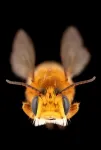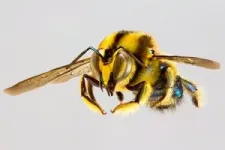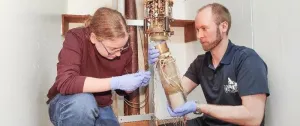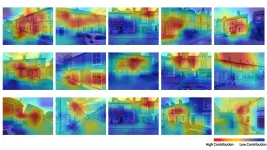(Press-News.org) A powerful new way to fill major gaps in public bee data – including from Africa, Asia and other under-reported zones – has been addressed with a centralised tool for consolidating bee pollinator occurrences around the globe.
Called BeeBCD, the package outlined in a new Nature journal article, brings together more than 18 million bee occurrence records from multiple public and private databases to improve accuracy and accessibility of species data from around the world for future conservation, research and farming management.
The rationalised bee occurrence datasets will help support future plant and crop production – as well as for important scientific communications, says lead author, Flinders University bee expert Dr James Dorey, in a new article in Scientific Data, a Nature Research journal.
The new BeeBDC (Dorey et al, 2023) package complements and links to the existing bdc (Ribeiro et al. 2022) and CoordinateCleaner (Zizka et al. 2019) as a new ‘arsenal’ for entomologists and other experts to quickly and reliably mobilise occurrence datasets, he says.
“Simplifying the workflow to use global bee occurrence data has been a big task – and will be foundational for biodiversity analysis, particularly with climate change, land clearance and pollution leading to rising extinction rates, crop failure and loss of native plant diversity.
“With mounting pressures on pollinating insects and other animals, we hope this ‘democratisation’ of a consistent reference point for species occurrence data will be an example for other such projects to follow.
“We already have researchers around the world using BeeBDC and the database to examine important continental and clade-wide questions connected to bee-plant and bee-environment interactions, impacts of invasive species, and broad bee ecology and evolution.”
“The project has already shown that regions with potentially high bee species diversities, such as Asia and Africa, are very under-represented in the data collection, so this central portal could inspire more reporting from these important and under-funded regions into the future.”
The US Department of Agriculture (USDA) says native plants as well as more than 100 food crops valued at $US18bn grown in the United States depend on pollination, including from more than 4000 species of wild bees. As well as honeybees, the department notes many environmental stressors on both native and managed pollinators including clean air and water, other habitat changes, pesticides and climate change.
Senior author Dr Neil Cobb, Director of the US not-for-profit Biodiversity Outreach Network and lead principal investigator of the iDigBees.org project funded by the National Science Foundation, says BeeBDC provides “a significant contribution to address the ‘Wallacean Shortfall,’ by simply documenting where the 20,000+ species of bees occur “so we can begin to understand their evolutionary biogeography and better inform conservation efforts”.
“These services, and many organisations, are helping to bring together science, researchers and the general public,” Dr Cobb says. “We need to widen and increase our collective efforts to reduce the impacts of human activities on our environments to improve outcomes for communities around the world.”
Authors of the article in Scientific Data hope the new model will enable The International Union for Conservation of Nature (IUCN) Wild Bee Specialist Groups to “spring into the task of assessing and conserving the world’s bee diversity’”.
“The BeeBDC project was inspired by wanting to allow anyone to safely access and use these critical pieces of information, and not just ‘mega labs’ at wealthy institutions,” adds Dr Dorey.
“Creating this treasure trove of easy-to-access, audited information will now inspire new research into important fields of discovery and encourage better public outreach materials,” he says, also acknowledging community science data in iNaturalist and data aggregators such as the Symbiota Collection of Arthropod Network (SCAN) and Global Biodiversity Information Facility which also encourage understanding of the natural world around us.
The article – A globally synthesised and flagged bee occurrence dataset and cleaning workflow (2023) by James B Dorey, Erica E Fischer, Paige R Chesshire, Angela Nava Bolaños, Robert L O’Reilly, Silas Bossert, Shannon M Collins, Elinor M Lichtenberg, Erika M Tucker, Allan Smith-Pardo, Armando Falcon-Brandis, Diego A Guevara, Bruno Ribeiro, Deigo de Pedro, John Pickering, Ken-Lou James Hung, Katherine A Parys, Lindsie M McCabe, Matthew S Rogan, Robert L Minckley, Santiago JE Velazco, Terry Griswold, Tracy A Zarrillo, Walter Jetz, Janina V Sica, Michael C Orr, Laura M Guzman, John S Ascher, Alice C Hughes and Neil S Cobb, will be published in Scientific Data (Nature) 2 November 2023 DOI:10.1038/s41597-023-02626-w.
The database project involved experts from King’s College London, North Arizona University, Universidad Nacional Autónoma de México, Washington State University, Smithsonian Institution, University of North Texas, Arizona and California government agencies, University of Kentucky, Universidad Nacional Colombia, Universidade Federal de Goiás (Brazil), Baja California Ensenada Centre for Scientific Research, Discover Centre US, University of Oklahoma, USDA ARS Pollinator Research Units, Yale University, University of Rochester, Universidad Nacional de Misiones (Argentina), Connecticut Agricultural Experiment Station, Staatliches Museum für Naturkunde Stuttgart. Chinese Academy of Sciences (Beijing), National University of Singapore and University of Hong Kong.
Acknowledgements: The research received support and funding from multiple organisations including the data providers, Biodiversity Outreach Network, US government, private scholarships and associated universities.
Captions: Courtesy James Dorey Photography (JamesDoreyPhotography.com.au) and Prof Michael Orr Please credit with this release
https://drive.google.com/drive/folders/1IqzeUIMNhCqZJ-jAsNW7A5pIBg3zugv-?usp=sharing
END
Buzz around new centralized pollination portal for better global bee data
2023-11-02
ELSE PRESS RELEASES FROM THIS DATE:
What a “2D” quantum superfluid feels like to the touch
2023-11-02
Researchers from Lancaster University in the UK have discovered how superfluid helium 3He would feel if you could put your hand into it.
The interface between the exotic world of quantum physics and classical physics of the human experience is one of the major open problems in modern physics.
Dr Samuli Autti is the lead author of the research published in Nature Communications.
Dr Autti said: “In practical terms, we don’t know the answer to the question ‘how does it feel to touch quantum physics?’
“These experimental conditions are extreme and the techniques complicated, but I can now tell ...
NIH grants support UCLA and Charles Drew University researchers' efforts to end HIV epidemic
2023-11-02
NIH grants support UCLA and Charles Drew University researchers' efforts to end HIV epidemic
The National Institutes of Health (NIH) has granted $2.1 million to UCLA’s Center for HIV Identification, Prevention, and Treatment Services (CHIPTS) and the UCLA-CDU Center for AIDS Research (CFAR) to support four research projects and an implementation science consultation hub. These awards will fund projects to strengthen research-community collaborations and enhance implementation strategies needed for the Ending the HIV Epidemic in the U.S. (EHE) initiative.
“These awards will support our scientists and ...
AI trained to identify least green homes by Cambridge researchers
2023-11-02
University of Cambridge media release
First of its kind AI-model can help policy-makers efficiently identify and prioritize houses for retrofitting and other decarbonizing measures.
FOR IMMEDIATE RELEASE
Model identified ‘hard to decarbonize’ houses with 90% precision and additional data will improve this.
Model trained with open source data including from energy performance certificates, and street and aerial view images. It could be used anywhere in the world.
Model can even identify specific parts of houses losing most heat, including roofs and windows.
‘Hard-to-decarbonize’ (HtD) houses are responsible ...
EU MiFID II unbundling rules damaged research and liquidity in London’s main stock market – new study
2023-11-02
New research from the University of Bath shows the European Union’s MiFID II financial market reforms inadvertently reduced research activity and adversely affected liquidity in London’s main stock market but that the impact on London’s less regulated Alternative Investment Market was mitigated by its special adviser rules.
The EU’s Markets in Financial Instruments Directive II (MiFID II) from 2018 aimed to improve transparency around research costs, which were previously bundled into brokers’ overall fees to clients. The legislation demanded the fees be ‘unbundled’ to make the hidden costs more explicit ...
International study led by researchers in Singapore reveals critical insights into timely interventions for maternal depression
2023-11-02
SINGAPORE – A large-scale international study spanning three continents, led by researchers from A*STAR’s Translational Neuroscience Programme of the Singapore Institute for Clinical Sciences (SICS) in Singapore, has found that maternal depressive symptoms begin from early pregnancy and can last up to two years after childbirth.
While health professionals often emphasise the postpartum stage after childbirth as a high-risk period for the onset of depression, findings from this latest study reveal a different reality – that maternal depressive symptoms can appear from early pregnancy ...
Paper argues reducing greenhouse gas emissions is not enough to combat climate change
2023-11-02
According to a new paper in Oxford Open Climate Change, published by Oxford University Press, the strategies humanity must pursue to reduce climate change will have to include more than reducing greenhouse gases. This comes from an analysis of climate data led by researcher James Hansen.
Scientists have known since the 1800s that infrared-absorbing (greenhouse) gases warm the Earth’s surface and that the abundance of greenhouse gases changes naturally as well as from human actions. Roger Revelle, who was one of the early scientists to study global warming, wrote in 1965 that industrialization meant that human ...
Research examines why mask usage in Japan persists
2023-11-02
Osaka, Japan – When you think of Japan in the age of COVID, you might imagine a crowd of people wearing masks. But why do so many Japanese people wear masks?
In an article published this month in the International Journal of Disaster Risk Reduction, a researcher from Osaka University analyzed mask use before and after the government of Japan downgraded the legal status of COVID-19. Results showed that many people continue to wear masks for socio-psychological reasons – including reasons related to ‘relief’ and ‘norm’.
Of course, the obvious motivation for mask use is disease prevention. In the first ...
Exercise therapy based on smart data to improve patients' quality of life
2023-11-02
Regular and moderate physical activity can significantly improve the quality of life of people with internal diseases such as cancer and depression. Unfortunately, many people with internal disorders cannot sufficiently participate in exercise training for several reasons. For example, they often do not have access to appropriate exercise training programs, have a high therapeutic burden, fatigue, or simply no time to engage in physical activity. Accordingly, the Sports Medicine research group led by Professor Perikles Simon at Johannes Gutenberg University Mainz (JGU) investigates how physical activity can be promoted and integrated into patients' daily lives by applying digital tools ...
Alternative antibiotic selection can reduce the risk of healthcare-associated infections for patients with pneumonia
2023-11-02
Arlington, Va. — November 2, 2023 — A new study published today in the American Journal of Infection Control (AJIC) reveals that the use of doxycycline may help protect against Clostridioides difficile (C. diff) infection for some patients with pneumonia. Specifically, study authors found that for hospitalized patients with community-acquired pneumonia who had experienced C. diff infections in the prior year, the use of doxycycline, instead of the more commonly used azithromycin, reduced the development ...
Survey finds most Americans are unaware of many signs that someone is having a seizure
2023-11-02
Orlando, Fla - If you’ve ever seen a movie or TV show in which a character has a seizure, you probably have a fairly standard mental picture of someone falling to the ground in full body convulsions while foaming at the mouth. But that doesn’t necessarily reflect reality. A new national survey by Orlando Health finds that while most Americans recognize those classic symptoms of what’s called a generalized tonic-clonic seizure, the majority fail to recognize the subtle signs, all of which can be dangerous and have a profound ...





